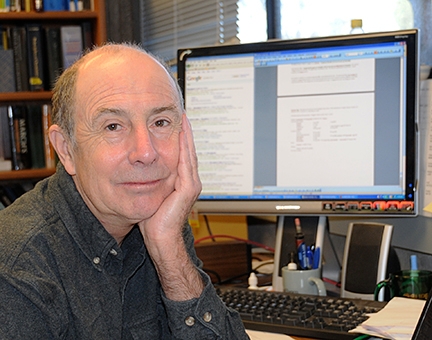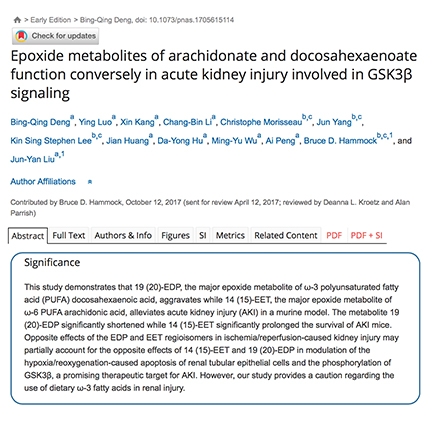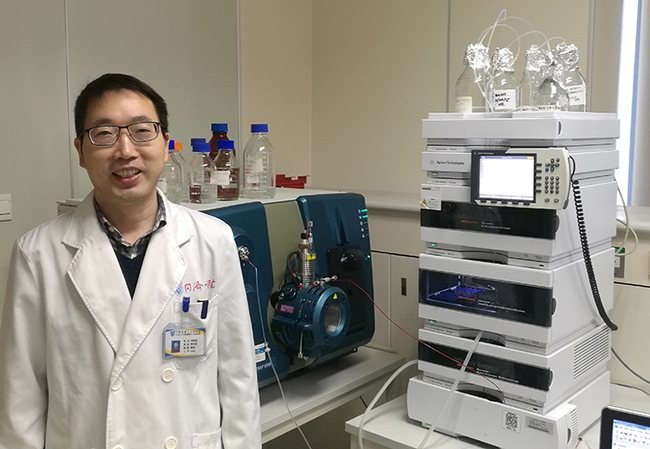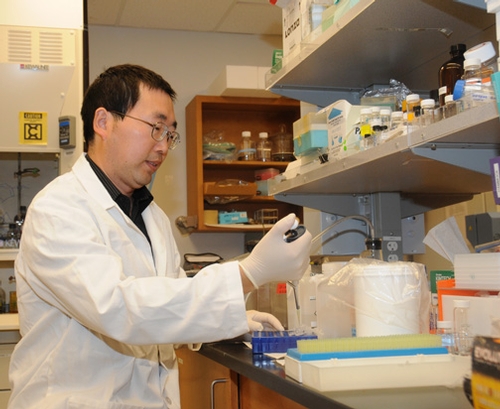- Author: Kathy Keatley Garvey

Make that a scientist who knows about soluble epoxide hydrolase, and a physician who knows about acute kidney injury (AKI), formerly called acute renal failure.
"It makes my brain hurt (reading it)," commented a colleague who is neither.
However, it's an important research paper published in the current edition of Proceedings of the National Academy of Sciences and it's co-authored by a distinguished UC Davis professor trained as an entomologist: Bruce Hammock, who holds a joint appointment with the UC Davis Department of Entomology and Nematology and the UC Davis Comprehensive Cancer Center.
The gist of it: newly published research by an international team of scientists, headed by the Jun-Yan Liu lab of Tongji University, Shanghai, China, and the Bruce Hammock lab at UC Davis, may provide promising therapeutic strategies for those suffering from acute kidney injury (AKI), formerly called acute renal failure. Access PNAS article.

“The soluble epoxide hydrolase or sEH degrades chemically stable fatty acid epoxides,” explained Hammock. “But sometimes it can be useful to block the function of sEH, so that beneficial fatty acid epoxides, like those from omega-3 and omega-6 fatty acids, are not degraded. These fatty acid epoxides have been found to protect the kidney, reduce inflammation, inflammatory pain, and even chronic or neuropathic pain.”
In general, the epoxides of docosahexaenoic acid (DHA) from fish oil make the soluble epoxide hydrolase inhibitors even more effective, the Hammock lab has found. “However, in this case, the fish oil seemed to be deleterious rather than beneficial when combined with the sEH inhibitors with kidney injury,” Hammock said. This was unexpected and the investigators caution that fish oil may not always have beneficial effects.
Professor Jun-Yan Liu, a former postgraduate researcher and assistant project scientist in the Hammock lab, related that the lipid mediators that preserve the kidney in AKI are termed EETs. “Their levels can be changed by altering their degradation or biosynthesis with selective inhibitors. This increase in EET resulted in anticipated decreases in the plasma level of creatinine and urea nitrogen—both biomarkers for kidney injury.” He added that they are looking forward to the epoxide hydrolase inhibitors finishing phase I clinical trials in humans so they can be evaluated for preventing or treating AKI.
Specifically, the researchers discovered that a 14(15)-EET mitigated kidney injury and prolonged life, while another epoxide, 19(20)-EDP from fish oil, exacerbated the kidney injury and shortened life. “We found that epoxides of docosahexaenoic acid (DHA) and DHA-enriched fish oil worsened kidney injury prophylactically and therapeutically in multiple animal models of AKI,” wrote Liu, pointing out that fish oil has proven beneficial in a number of other investigations.
Statistics show that “the incidence of AKI in hospitalized patients increased dramatically from 4.9 percent in 1983 to 20 percent in 2012,” the researchers wrote in their paper. “The mortality from AKI is greater than 50 percent; worldwide, approximately 2 million people die of AKI every year. Therefore, novel, safe and effective approaches are urgently needed to prevent and treat AKI.”
Says Weiss: “Because AKI has no specific effective therapy and treatment is merely supportive frequently requiring hemodialysis any new treatment or therapeutic paradigm would be welcome in the nephrology community and has the potential to improve the lives of many patients with AKI."
Kidney injury expert Alan Parrish of the University of Missouri's School of Medicine, Columbia, also not involved in the research, called the findings “significant.”
“The collaborative studies between Dr. Liu's and Hammock's group are an elegant, and timely, contribution to our understanding of acute kidney injury (AKI),” said Parrish, vice chair for education and director of Graduate Studies for Medical Pharmacology at the medical school. “AKI has potentially devastating short-term consequences - high mortality - as well as the detrimental long-term impact on renal function. Importantly, specific interventions to treat AKI in patients have not yet been identified. These results are significant in that they provide a unique mechanistic insight into pathways targeted by soluble epoxide hydrolase inhibitors that attenuate AKI, providing a powerful rationale for future clinical trials in AKI patients.”
Bruce Hammock knows well the tragedy of AKI and its terrible toll. "When I was in a burn unit in the U.S. Army, many patients faced their last few hours with sepsis and AKI. I have had my mom and cousin die of acute renal failure. It is not all that rare, and there is not much a doctor can do now except watch. Dialysis normally comes too late--and dialysis comes with its own problems."
The paper is the work of scientists led by Jun-Yan Liu from the Center for the Nephrology and Metabolomics and Division of Nephrology and Rheumatology, Tongji University School of Medicine, Shanghai, China: Bing-Qing Deng, Ying Luo, Xin Kang, Chang-Bin Li, Jian Huang, Da-Yong Hu, Ming-Yu Wu, and Ai Peng; and Hammock and his lab researchers Jun Yang, Christophe Morrisseau, Kin Sing Stephen Lee at UC Davis.
What's next?
"For humans, we are supported by the National Institutes of Health Blueprint Program to take this through Human Phase I," Hammock says. "We hope to be in Phase 1 next year. We are looking for support for Phase II. Once Phase 1 is finished, there should be an IND that can be referenced for physician-initiated trials. We are looking for angel or venture funding for similar FDA trials in horses and companion animals.”
“The epoxy fatty acids and sHE inhibitors block ER stress," Hammock says. "Thus, they should help with a number of disorders that arise from ER stress. We are first targeting neuropathic pain in humans and inflammatory pain in horses and companion animals.”
The intellectual property status? “Some licensed by the University of California to EicOsis LLC (a company founded by Hammock, the CEO) and others are EicOsis patents.”
Licensing? “Licensed exclusively to EicOsis, but EicOsis is interested in partnerships or sublicenses for specific indications.”
Resources:
Access PNAS article
Hammock lab: http://www.biopestlab.ucdavis.edu/Epoxide_Hydrolase/

- Author: Kathy Keatley Garvey
Pest management. Pain management.
Early in his career, entomologist Bruce Hammock, now a distinguished professor of entomology at the University of California, Davis and a newly selected fellow of the Entomological Society of America, probed regulating the development of insect larvae.
Pest management.
Now his interests swing toward pain management, including inflammatory diseases like arthritis.
His is truly a case of "from the bench to the bedside."
Today two UC Davis labs--including Hammock's--and a lab from Peking University, China published an article in Proceedings of the National Academy of Sciences (PNAS) that is sure to offer hope down the road for those suffering from arthritis pain.
The scientists found a novel mechanism as to why the long-term, high-dosage use of the well-known arthritis pain medication, Vioxx, led to heart attacks and strokes. Their groundbreaking research, done with rodents, may pave the way for a safer drug for millions of arthritis patients who suffer acute and chronic pain.
“This is a major breakthrough that can lead to a better medication for people suffering from acute pain,” said Hammock, who has a joint appointment at the UC Davis Cancer Center.
The Hammock lab and two others labs--the lab of cell biologist Nipavan Chiamvimonvat, UC Davis Division of Cardiovascular Medicine, and physiologist Yi Zhu, Peking University--used metabolomic profiling to analyze murine (rodent) plasma. They discovered that Vioxx causes a dramatic increase in a regulatory lipid that could be a major contributor to the heart attacks and strokes associated with high levels of the drug and other selective COX-2 inhibitors, known as “coxibs.”
“Our metabolomics study discovered that 20-hydroxyeicosatetrasanoic acid, also known as 20-HETE, contributes to the Vioxx-mediated cardiovascular events,” said UC Davis bioanalytical chemist Jun-Yan Liu, the senior author of the paper and a five-year member of the Bruce Hammock laboratory.
Millions of arthritis patients took Vioxx before its withdrawal from the global market in 2004. Vioxx, a nonsteroidal anti-inflammatory drug (NSAID) and coxib for acute and chronic pain, particularly for arthritis and osteoarthritis, was on the market for five years. Merck & Co. voluntarily withdrew it in September 2004 due to concerns about the increased risk of heart attacks and strokes.
The chronic administration of high levels of selective COX-2 inhibitors, particularly rofecoxib, and valdecoxib, increases the risk for cardiovascular disease, Liu said.
Urologist Ralph devere White, professor of urology at the UC Davis School of Medicine and director of the UC Davis Cancer Center, described the research as “extremely exciting.”
“Vioxx and other drugs in this class were looked on as extremely promising in moderation,” devere White said. “The fact that the Hammock lab discovered why the drug could lead to heart attacks and strokes and is able to quantify the deleterious facts is extremely exciting. I hope that patients can safely use this drug in the future or block the deleterious effects so it will have all of the benefits and none of the adverse side effects.”
Nationally, some 46 million individuals suffer from arthritis. “And almost one million patients are admitted to hospitals every year because of their arthritis,” Hammock said. “They do need effective and safer drugs to relieve their pain.”
This research (see the UC Davis Department of Entomology website) will undoubtedly open up new strategies to develop safer coxibs.




